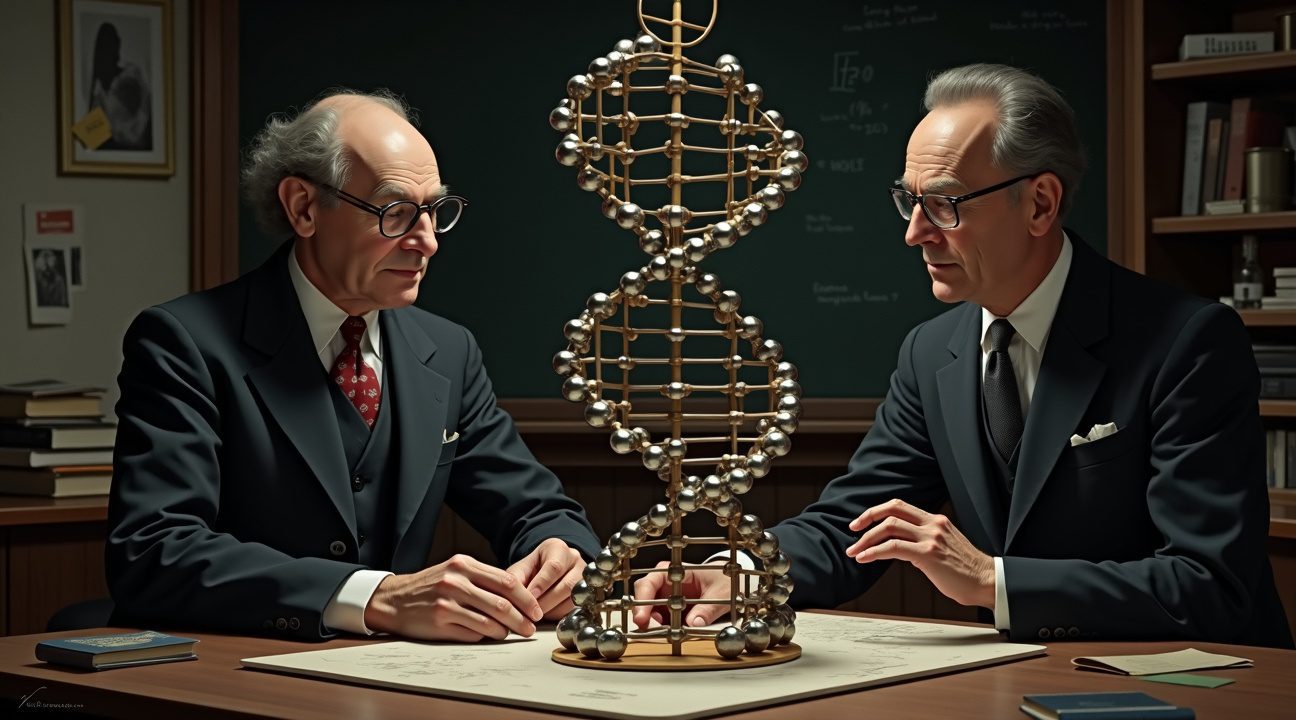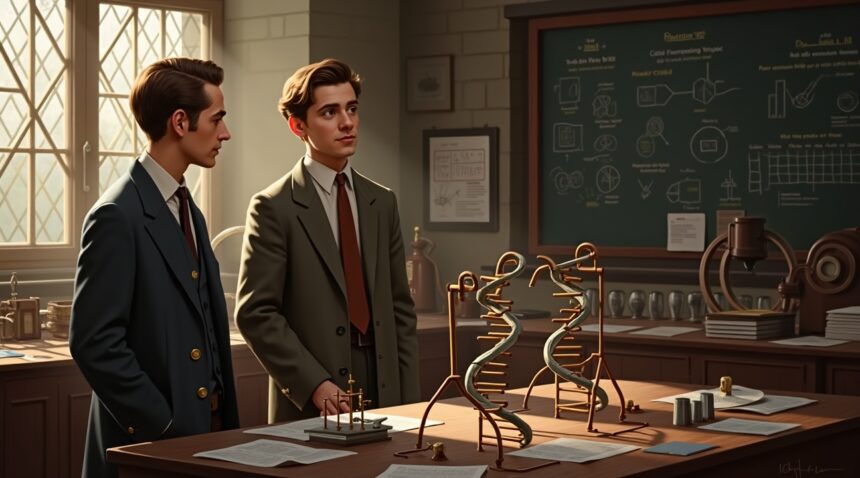James Watson, the Nobel Prize-winning scientist who helped discover DNA’s structure, passed away at age 97 on November 6, 2025, leaving behind one of the most transformative scientific legacies of the modern era.
His groundbreaking 1953 discovery of DNA’s double helix structure, made when he was just 25 years old, fundamentally changed how scientists understand life itself. This breakthrough launched the genetic revolution that continues to shape medicine and biotechnology today.
Key Takeaways
- Watson co-discovered the double helix structure of DNA in 1953 with Francis Crick at Cambridge University, revealing how genetic information is stored and transmitted in living organisms.
- He received the Nobel Prize in Physiology or Medicine in 1962, sharing the honor with Francis Crick and Maurice Wilkins for their collaborative research on nucleic acid structure.
- Watson led the transformation of Cold Spring Harbor Laboratory into a world-renowned genetics research center and initially directed the Human Genome Project before resigning in 1992 due to conflicts of interest.
- His scientific legacy includes foundational contributions to molecular biology, genetic engineering, and DNA sequencing technologies that enable modern medical treatments and biotechnology advances.
- Despite his revolutionary scientific achievements, Watson’s later career was overshadowed by controversial statements about race and intelligence, leading to his professional ostracism from the scientific community.
Nobel Prize Winner James Watson Dies at 97 After Groundbreaking Career in Genetics
James Dewey Watson passed away on November 6, 2025, in East Northport, New York, at the age of 97. He left behind a revolutionary legacy in genetics that fundamentally changed how scientists understand life itself.
Watson achieved his most famous breakthrough in 1953 while working at Cambridge University’s Cavendish Laboratory. At just 25 years old, he collaborated with Francis Crick to uncover the double helix structure of DNA. This discovery ranks among the most significant scientific achievements of the 20th century, providing the key to understanding how genetic information is stored and transmitted in living organisms.
Scientific Recognition and Personal Life
The significance of Watson’s work earned him the Nobel Prize in Physiology or Medicine in 1962. He shared this prestigious honor with Francis Crick and Maurice Wilkins for their collaborative research on the molecular structure of nucleic acids. The award cemented Watson’s place among the giants of modern biology.
Beyond his professional achievements, Watson built a family life with Elizabeth Lewis, whom he married in 1968. The couple had two sons, Rufus and Duncan, who survived their father along with their mother. His personal life remained relatively private compared to his prominent scientific career.
Watson’s research opened doors to countless advances in genetics and molecular biology. His work laid the foundation for modern genetic engineering, DNA sequencing technologies, and countless medical breakthroughs that followed. The discovery continues to influence fields ranging from medicine to forensics, making it possible to recreate extinct species from DNA in some cases.
Scientists worldwide recognize Watson’s contribution as the starting point for the genetic revolution. His death marks the end of an era for those who witnessed firsthand the birth of modern molecular biology. The double helix structure he helped reveal remains one of the most recognizable symbols in science, representing the fundamental blueprint of life itself.
Watson’s passing comes at a time when genetic research continues to advance rapidly, building upon the foundation he helped establish over seven decades ago. His work enabled subsequent generations of researchers to decode the human genome and develop revolutionary treatments for genetic diseases.

The 1953 Discovery That Changed Biology Forever
I witnessed one of science’s most revolutionary moments when James Watson and Francis Crick unveiled the double helical structure of DNA in 1953. Their groundbreaking work at Cambridge University’s Cavendish Laboratory transformed our understanding of life itself, revealing how genetic information passes from one generation to the next.
The discovery centered on DNA’s elegant structure, which Watson and Crick famously described as a “gently twisted ladder.” This double helix consists of two intertwined strands held together by complementary base pairs. The genius of their model lay in showing how these base pairs – adenine with thymine, and guanine with cytosine – create a perfect template for self-replication.
The Collaborative Effort Behind the Breakthrough
Watson was remarkably young at just 25 years old when he made this historic discovery. Working alongside Francis Crick, he built upon essential data provided by collaborators Rosalind Franklin and Maurice Wilkins. Franklin’s X-ray crystallography work, particularly her famous “Photo 51,” provided critical insights into DNA’s helical structure. Wilkins’ contributions through his own X-ray diffraction studies helped confirm the double-stranded nature of the molecule.
The team’s collaborative approach proved crucial in solving what many considered the most important biological puzzle of the time. Each scientist brought unique expertise that contributed to the final breakthrough.
Impact on Modern Science and Medicine
Their research, published in the prestigious journal Nature, became the cornerstone for understanding heredity and genetic information transfer. The double helix model explained how DNA stores genetic instructions and how these instructions copy themselves during cell division. This mechanism of replication ensures that genetic information passes accurately from parent cells to daughter cells.
The implications stretched far beyond basic biology. Understanding DNA’s structure opened doors to numerous scientific advances that continue today. Modern genetic research, including efforts to recreate extinct species from DNA, builds directly on Watson and Crick’s foundational work.
The discovery revolutionized medicine by explaining how genetic diseases occur and potentially how they might be treated. Scientists now understand that changes in base pair sequences can lead to genetic disorders, cancer, and other health conditions. This knowledge has enabled the development of:
- Genetic testing
- Gene therapy
- Personalized medicine approaches
The 1953 breakthrough also laid the groundwork for biotechnology industries that didn’t exist before. DNA sequencing, genetic engineering, and molecular diagnostics all stem from understanding the double helix structure. Pharmaceutical companies now design drugs that target specific DNA sequences or proteins encoded by genes.
Agricultural science benefited enormously as well. Scientists can now modify crop plants by understanding exactly how genetic traits pass from parent plants to offspring. This knowledge has led to crops with:
- Improved nutrition
- Disease resistance
- Increased yield
The work established Cambridge University as a premier center for molecular biology research. The success attracted brilliant minds from around the world and established research traditions that continue producing groundbreaking discoveries.
Watson’s youth at the time of discovery demonstrates how fresh perspectives can solve complex scientific problems. His collaboration with the more experienced Crick created a perfect partnership between enthusiasm and expertise. Their work shows how scientific breakthroughs often result from combining different approaches and building on others’ research.
The double helix model’s elegance lies in its simplicity and explanatory power. By revealing how four simple bases – adenine, thymine, guanine, and cytosine – arrange themselves to store and transmit life’s information, Watson and Crick provided a unifying principle for all biology. Every living organism, from bacteria to humans, uses this same basic mechanism to preserve and pass on genetic information.
Their discovery continues influencing scientific research decades later. Modern scientists studying everything from evolution to disease mechanisms rely on principles established by Watson and Crick’s 1953 work. The double helix remains one of science’s most recognizable symbols, representing humanity’s quest to understand life’s fundamental mechanisms.

From Child Prodigy to Scientific Leadership
James Watson’s extraordinary journey began on April 6, 1928, when he was born in Chicago, Illinois. His exceptional intellect became apparent early, displaying the kind of brilliant mind that would later revolutionize molecular biology.
Accelerated Academic Achievement
Watson’s academic trajectory defied conventional timelines from the start. He enrolled at the University of Chicago at the remarkably young age of 15, demonstrating intellectual capabilities that placed him years ahead of his peers. By 1947, at just 19 years old, he had earned his Bachelor of Science degree in Zoology, setting the stage for what would become one of the most influential scientific careers of the 20th century.
His academic momentum continued with equal intensity at Indiana University, where he pursued his doctoral studies. Watson completed his PhD in Zoology in 1950, achieving this advanced degree at the age of 22. This rapid progression through higher education reflected not only his natural abilities but also his focused determination to understand the fundamental mechanisms of life.
Building a Scientific Empire
Watson’s transition from promising student to scientific leader began when he joined Harvard University as a professor from 1961 to 1976. During his tenure at Harvard, he focused his research efforts on understanding the crucial role of nucleic acids in protein synthesis, work that would prove essential to advancing the field of molecular biology. His contributions during this period helped establish the foundation for modern genetic research and biotechnology.
The most transformative chapter of Watson’s leadership began in 1968 when he accepted the position of director at Cold Spring Harbor Laboratory. Under his guidance, this institution underwent a dramatic transformation, evolving from a modest research facility into a global powerhouse in genetics and cancer research. Watson’s vision and leadership style attracted top-tier scientists and secured significant funding, creating an environment where groundbreaking discoveries could flourish.
His impact on cancer research proved particularly significant during his time at Cold Spring Harbor Laboratory. The institution became instrumental in uncovering the molecular basis of cancer, leading to the identification of critical cancer genes that would inform treatment approaches for decades to come. Watson’s emphasis on rigorous scientific methodology and collaborative research created a culture of innovation that produced numerous breakthrough discoveries.
The laboratory’s work under Watson’s direction contributed substantially to our understanding of how genetic mutations lead to cancer development. This research laid the groundwork for targeted cancer therapies and personalized medicine approaches that continue to benefit patients today. His ability to recognize promising research directions and support them with necessary resources demonstrated exceptional scientific leadership.
Watson’s influence extended beyond his own research to mentoring the next generation of scientists. Many researchers who trained under his guidance went on to establish their own successful laboratories and make significant contributions to molecular biology and genetics. His approach to scientific education emphasized critical thinking and rigorous experimental design, principles that became hallmarks of modern biological research.
The transformation of Cold Spring Harbor Laboratory under Watson’s leadership serves as a model for how visionary scientific leadership can amplify research impact. His understanding of both the technical aspects of molecular biology and the practical requirements of running a world-class research institution allowed him to create an environment where scientific excellence could thrive.
Throughout his career, Watson maintained his focus on fundamental questions about life’s molecular mechanisms. His work contributed to advances that would later influence fields ranging from forensic science to DNA reconstruction research, demonstrating the far-reaching implications of basic scientific research. His legacy in scientific leadership continues to influence how research institutions approach complex biological questions and organize collaborative scientific efforts.
Leading the Human Genome Project and Sudden Departure
James Watson’s appointment as Associate Director of the Human Genome Project in 1988 marked another pivotal chapter in his scientific career. The National Institutes of Health had entrusted him with overseeing one of the most ambitious scientific undertakings in modern history. Within a year, he ascended to the role of Director, positioning himself at the helm of an international effort that would fundamentally change how we understand human biology.
Mapping the Complete Human Genetic Code
The Human Genome Project represented an extraordinary scientific challenge that required mapping all human genes. Scientists initially estimated the human genome contained between 50,000 and 100,000 genes, each holding crucial information about human development and disease. Watson understood that successful gene mapping would revolutionize medicine by enabling genetic testing for hereditary diseases and opening pathways for targeted treatments.
Under his leadership, the project established several key objectives:
- Determining the sequence of the 3 billion chemical base pairs that make up human DNA
- Identifying and mapping all human genes within the DNA sequences
- Storing this genetic information in databases accessible to researchers worldwide
- Developing tools and technologies for genetic analysis and interpretation
- Addressing the ethical, legal, and social implications of genetic research
The scope of this undertaking required unprecedented international collaboration between research institutions, universities, and government agencies. Watson championed an open-access approach, believing that genetic discoveries should benefit all humanity rather than remain proprietary to individual organizations or countries.
Controversial Exit from the Project
Watson’s tenure as Director came to an abrupt end in 1992 when mounting controversies forced his resignation from the NIH. The primary source of conflict centered on his simultaneous involvement with private biotechnology companies while directing the publicly funded Human Genome Project. Critics argued that his financial interests in these companies created unacceptable conflicts of interest that compromised the project’s integrity.
The controversy intensified as questions arose about the project’s increasing collaboration with private sector entities. Some scientists and ethicists worried that commercial interests might influence research priorities or restrict access to genetic information that should remain in the public domain. Watson’s investments in biotechnology firms that could potentially profit from genome research findings placed him in an untenable position.
His departure sent shockwaves through the scientific community, particularly given his instrumental role in establishing the project’s framework and international partnerships. The sudden leadership change forced the NIH to reassess its policies regarding conflicts of interest and private sector involvement in publicly funded research initiatives.
Despite his early exit, Watson’s contributions to launching the Human Genome Project proved foundational. His vision of comprehensive gene mapping laid the groundwork for what would eventually become one of science’s greatest achievements. The project continued under new leadership and successfully completed its primary goals by 2003, well ahead of the original 15-year timeline.
The genetic technologies and treatments that emerged from this massive undertaking validated Watson’s initial belief that mapping the human genome would transform medicine. Modern genetic testing now identifies hereditary diseases before symptoms appear, while targeted therapies treat conditions based on individual genetic profiles. His early leadership helped establish the scientific and organizational framework that made these advances possible, even though ethical concerns about his private interests cut short his direct involvement in seeing the project through to completion.

Influential Books and Growing Controversies
I find Watson’s literary contributions to be as significant as his scientific discoveries, though they came with their share of complications. His prolific writing career produced several foundational texts that shaped how people understand molecular biology and the process of scientific discovery itself.
Major Publications and Academic Impact
Watson’s most famous work, The Double Helix (1968), became a bestselling memoir that offered readers an unprecedented behind-the-scenes look at scientific discovery. This candid account of the race to uncover DNA’s structure sparked immediate controversy among his colleagues, who criticized his frank portrayal of the competitive nature of research and his sometimes unflattering descriptions of fellow scientists. Despite the criticism, the book became essential reading for understanding how major scientific breakthroughs actually happen.
His academic textbook, Molecular Biology of the Gene (1965), established itself as a cornerstone of biological education and influenced countless students entering the field. Watson followed this with several other influential works:
- The DNA Story (1981), which explored the implications of genetic research
- Recombinant DNA: A Short Course, providing accessible explanations of genetic engineering
- Genes, Girls and Gamow (2003), a personal memoir reflecting on his scientific career and relationships
These publications demonstrated Watson’s ability to communicate complex scientific concepts to both academic and general audiences, cementing his role as not just a researcher but also an educator and science communicator.
Watson’s achievements earned him numerous prestigious honors throughout his career. The 1962 Nobel Prize in Physiology or Medicine, shared with Francis Crick and Maurice Wilkins, recognized their groundbreaking work on DNA structure. Later accolades included the Copley Medal in 1993, one of the Royal Society’s highest honors, and the Presidential Medal of Freedom, America’s highest civilian award.
However, Watson’s career took a dramatic turn due to controversial public statements he made regarding genetics and intelligence. Comments he made in 2007 suggesting a link between race and intelligence created significant backlash from the scientific community and the public. These statements contradicted decades of scientific consensus that intelligence cannot be attributed to racial differences.
The controversy intensified when Watson made similar remarks in 2019, leading to severe professional consequences. Cold Spring Harbor Laboratory, where he had served in leadership roles for decades, stripped him of his honorary titles and effectively severed ties with the renowned scientist. This action represented a significant fall from grace for someone who had once been celebrated as one of biology’s greatest minds.
Watson’s resignation from his positions marked the end of an era at Cold Spring Harbor Laboratory, where he had built his reputation as both a scientist and administrator. The laboratory’s decision to distance itself from Watson reflected the scientific community’s commitment to rejecting views that lack scientific basis and promote harmful stereotypes.
The contrast between Watson’s scientific achievements and his later controversies illustrates the complex legacy he leaves behind. While his contributions to understanding DNA structure revolutionized biology and medicine, his harmful statements about race and intelligence overshadowed these accomplishments in his final years. This situation mirrors broader discussions about how the scientific community should handle instances where respected researchers make statements that contradict scientific evidence and promote discrimination.
Just as James Cameron warned about AI, Watson’s case serves as a reminder that scientific expertise in one area doesn’t necessarily translate to wisdom in others, and that even Nobel laureates can fall from grace when they abandon scientific rigor in favor of personal bias.
A Complex Scientific Legacy
James Watson’s groundbreaking work fundamentally transformed our understanding of life itself. His collaboration with Francis Crick in discovering DNA’s double helix structure in 1953 established the blueprint for all subsequent advances in molecular biology. This discovery didn’t just solve a scientific puzzle—it opened entirely new fields of research that continue to shape medicine and biotechnology today.
Foundations of Modern Biology
Watson’s revelation of DNA’s structure provided the key to understanding how genetic information is stored, replicated, and transmitted across generations. His work enabled scientists to develop recombinant DNA technology, which allows researchers to manipulate genetic material with precision. This breakthrough led directly to the development of genetic engineering, cloning techniques, and eventually the Human Genome Project. Modern biotechnology companies rely on principles Watson helped establish, creating everything from life-saving medications to ambitious DNA recreation projects.
The double helix model Watson co-discovered became more than just a scientific diagram—it evolved into a universal symbol representing genetics and scientific discovery itself. Genome sequencing technologies, which now allow scientists to read entire genetic codes in hours rather than years, trace their origins back to Watson’s fundamental insights about DNA structure.
Enduring Scientific Impact
Watson’s contributions extend far beyond his initial discovery. His work established the conceptual framework that allowed subsequent generations of scientists to decode the genetic basis of diseases, develop targeted therapies, and create diagnostic tools that save millions of lives annually. The principles he helped uncover continue to drive innovation in personalized medicine, where treatments are customized based on individual genetic profiles.
Despite controversies that emerged later in Watson’s career regarding his personal views, the scientific community widely recognizes his pivotal role in revealing DNA’s structure as one of the 20th century’s greatest achievements. His discovery ranks alongside Einstein’s theory of relativity and Darwin’s theory of evolution in terms of its profound impact on human understanding of the natural world. The technological revolution spawned by Watson’s work touches virtually every aspect of modern life, from agriculture to medicine to forensic science, cementing his position as one of history’s most influential scientists.

Sources:
Academy of Achievement, “James D. Watson, Ph.D.”
Encyclopædia Britannica, “James Watson | Biography, Nobel Prize, Discovery, & Facts”
Wikipedia, “James Watson”
Indiana University, “James Dewey Watson: University Honors and Awards”
NobelPrize.org, “James Watson – Biographical”
DNA Learning Center, “Biography 19: James Dewey Watson (1928 – )”
National Library of Medicine, “The Discovery of the Double Helix, 1951–1953 | Francis Crick”
Wikipedia, “The Double Helix”


